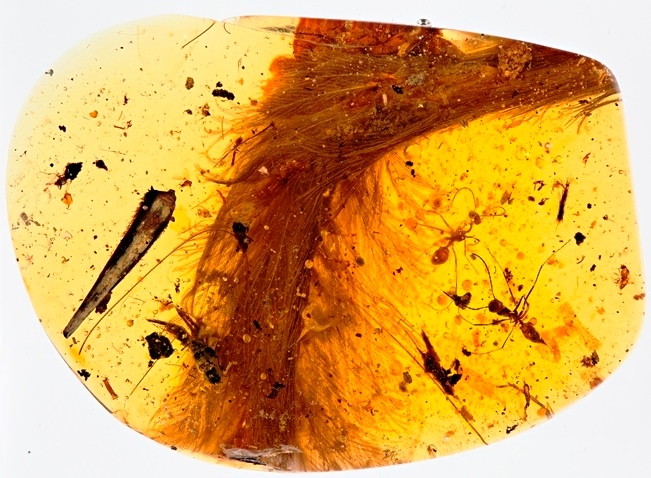Recent excavations in Asia unearthed a pristine, three-dimensional fossil of a tiny dinosaur tail with preserved feathers and soft tissues (presumably skin). In 2016, investigators in northern Myanmar (Burma) recovered a piece of Cretaceous-era amber (Fig. 1) containing an approximately 99-million-year-old feathered tail from a theropod dinosaur. (Theropods are carnivorous bipedal saurischian reptiles that first appeared in the Upper Triassic and culminated in the uppermost Cretaceous.) Although the size of the tail measures only 37 mm (1.46 in.), eight vertebrae can be identified, and the morphological structure of the plumage is clearly observable. See also: Amber; Cretaceous; Dinosauria; Fossil; Saurischia

Based on this remarkable specimen, researchers have hypothesized that the creature in question was a juvenile coelurosaur (a birdlike theropod) resembling a tiny Tyrannosaurus rex. Previously, other researchers have found fossils with impressions or indications of filaments or feathers, and individual feathers have even been found in amber. However, until now, investigators were not able to directly associate a well-preserved feather with a specific dinosaur. Based on the extraordinary preservation and clarity of the Myanmar specimen, paleontologists have been able to finally make such an association. See also: Feather; Morphometrics in paleontology; Paleontology
The preserved feathers (Fig. 2) provide a unique opportunity to observe feather counts and orientations, as well as other features of this coelurosaur. Most importantly, the rachis is not well developed. In modern birds, the rachis is a long shaft located down the center of certain feathers (most often those used for flight). The rachis supports rows of small branchlike structures (barbs) along each side. However, because the rachis is poorly defined in the Myanmar amber specimen, the feathers were likely ornamental in nature or had a signaling function. It also is possible that these feathers were used in temperature regulation. In addition, the colors of the feathers, identified using various microscopy techniques, are chestnut brown on top, and pale or white on the underside. The most notable characteristic of the vertebrae is that they are articulated, thereby eliminating the possibility that the specimen came from a prehistoric bird (in which case, the tail vertebrae would have been fused to form a structure called a pygostyle), and indicating that the specimen was indeed a dinosaur. See also: Aves; Microscope; Temperature adaptation; Vertebra

The Myanmar amber specimen provides taxonomists and evolutionary biologists with a new perspective on the origin of birds. Feathers—the hallmark of birds—likely appeared first in theropod dinosaurs; however, the previous fossil record did not preserve such information. This recent discovery fills the gap and has been a boon to researchers seeking to analyze the evolutionary development of feathers. It also highlights the unique preservation potential of amber for understanding the morphology and evolution of coelurosaurian structures. See also: Avian evolution; Cretaceous bird radiation; Dino-Birds; Evolution of theropod dinosaurs





